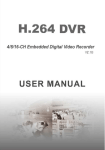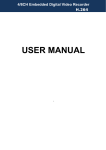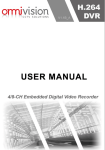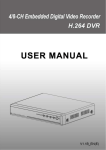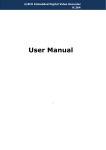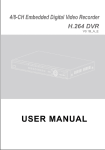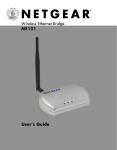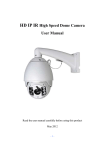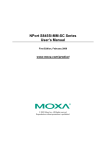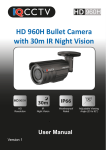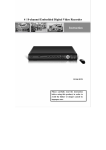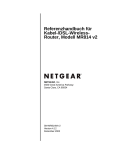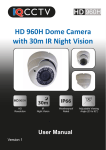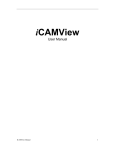Download IQR4D User Manual
Transcript
IQR4D 4 Camera DVR with Real Time D1 Recording and Mobile/Internet Access User Manual TECHNICAL SUPPORT: For Technical Support please contact your local distributor. LIMITED WARRANTY: This product is supplied with a 1 Year warranty. The Warranty excludes products that have been misused, (including accidental damage) and damage caused by normal wear and tear. In the unlikely event that you encounter a problem with this product, it should be returned to the place of purchase. IQCCTV IQR4D – 4 Camera DVR Notes The power supply of this DVR is provided through DC12V (3 Amp) adapter. Please check the power outlet before installation and ensure it can meet the requirements of adaptor. Do not place the DVR at a place subject to rain or moisture. Do not install the DVR at a place subject to violent vibration. Do not install the DVR at a place subject to direct sunlight, and be far away from heat and high temperature environment. The back panel shall be 15cm or more away from other objects or wall, to facilitate fan cooling. The DVR shall work under temperature, humidity and voltage according to its technical specifications. The DVR should not be stored with corrosive chemicals that may produce volatile gases. The DVR shall be installed in a space without much dust, and the environment should be kept clean and tidy. Proper grounding shall be installed during operation. DVR should be installed to ensure the proper connectivity with other devices. Ensure a suitable and compatible hard drives are used in the DVR. IQCCTV IQR4D – 4 Camera DVR Chapter 1 Overview ................................................................................................ 5 1.1 Introduction ................................................................................................... 5 1.2 Packaging and accessories ............................................................................. 5 1.3 Main features ................................................................................................. 5 1.4 Technical Specifications .................................................................................. 6 1.5 Product appearance and interface definition ................................................ 7 1.6 Remote controller .......................................................................................... 8 1.7 Mouse ............................................................................................................ 9 Chapter 2 Quick installation .................................................................................... 9 2.1 HDD Installation ........................................................................................... 10 2.2 Boot .............................................................................................................. 10 2.3 System login ................................................................................................. 10 2.4 Shortcut menu ............................................................................................. 11 Chapter 3 Advanced settings ................................................................................. 14 3.1 Main menu ................................................................................................... 14 3.2 Recording mode ........................................................................................... 14 3.3 Video search ................................................................................................. 15 3.4 Backup .......................................................................................................... 17 3.5 Hard drive management .............................................................................. 18 3.6 Basic setup ................................................................................................... 19 3.7 Advanced...................................................................................................... 22 3.8 Domain name application ............................................................................ 30 3.9 Port forwarding ............................................................................................ 32 Chapter 4 DVR network......................................................................................... 34 4.1 Functional characteristics ............................................................................ 36 4.2 Installation and download of controls ......................................................... 36 4.3 IE login .......................................................................................................... 37 4.4 Real-time preview ........................................................................................ 37 4.5 Record playback ........................................................................................... 38 4.6 Recording mode ........................................................................................... 39 IQCCTV IQR4D – 4 Camera DVR 4.7 Alarm setup .................................................................................................. 39 4.8 PTZ control ................................................................................................... 40 4.9 Network setup.............................................................................................. 40 4.10 System setup .............................................................................................. 41 4.11 Host info ..................................................................................................... 41 Chapter 5 Client software & Player .................................................................... 42 5.1 Client software ............................................................................................. 42 5.2 Video Player ................................................................................................. 43 Appendix 1. Frequently Asked Questions .......................................................... 47 Appendix 2 Hard Drive Space Calculation Table................................................. 49 Appendix 3 DVR Connections............................................................................. 49 IQCCTV IQR4D – 4 Camera DVR Chapter 1 - Overview 1.1 Introduction This IQR4D is a low-cost 4 Camera DVR with remote and mobile phone access. The DVR adopts the industry's most advanced technology including H.264 compression codec, providing the highest picture quality but efficient use of recording space. The DVR’s body is designed as a stylish small form that allows it to be stored away discreetly. 1.2 Packaging and accessories Following parts are included in the package: IQR4D DVR IR remote controller x2 Batteries (for the remote controller) Instruction Manual Power Adapter Central Management Software (CMS) CD 1.3 Main features Standard H.264 video compression format 16-bit true-color semi-transparent graphical menu interface, menu options tip A variety of recording modes: manual, timing, motion and alarm recording Optimized 4-Channel simultaneous playback A variety of backup (USB drives, mobile hard drives or via networks) X2 USB ports (x1 USB2.0 for data backup, x1 USB1.1 for the mouse operations) Multi-functional Operation; recording, playback, monitor, backup and network transmission can be realized at the same time Dual stream technology Support network to implement multi-screen real-time browsing, parameter setting, copy or playback Support mobile phone monitoring for remote access Support event classification and precise time search and playback Defaulted parameter value fast recovery Flexible USB interface for mouse IQCCTV IQR4D – 4 Camera DVR 1.4 Technical Specifications Features Operating system Video compression Video/Audio input Video/ Audio output Alarm input/output Display spilt VGA output Multiplex operation Recording mode Recording frame rate Recording quality Recording resolution Recording playback Recording backup HDD Network transmission Capture function Email alarm PTZ control PTZ protocol PIP Zoom Network and protocol IE browser Client software CMS Dual stream Multi-language Mobile phone surveillance Mouse interface Backup interface Remote controller User authority Power Working temperature Working humidity SIZE(mm) Description Embedded LINUX OS H.264 4 CH BNC 1 CH BNC N/A 1/4 Channel Support 600*800 1024*768 1280*1024@60Hz Live, recording, network, ,mobile phone surveillance simultaneously Timer/manual/motion detection/alarm PAL:25fps NTSC:30fps adjustable High, normal ,low CIF/Half-D1/D1 4 Channel playback simultaneously Support USB flash drive, mobile hard drive, network backup Support 1 SATA HDD,capacity to 2T 4 Channels real-time network transmission with CIF resolution Support Send pictures to the designated Email box Support PELCO-D,PELCO-P Support Support 1 RJ-45 10/100M via Ethernet, support TCP/IP, SMTP, DHCP, DNS, DDNS, NTP etc. Support, max five users online Support, max five users online Support Support (main and secondary interchange) Support Support Windows, Symbian (Nokia), iPhone, Blackberry, Android USB1.1 USB2.0 Support Support multi-level user authority distribution DC12V/3A -20℃-60℃ 10%-90% 274(W)*214(D)*45(H) IQCCTV IQR4D – 4 Camera DVR 1.5 Product appearance and interface definition 1.5.1 Front panel 1.5.2 Back panel Interface Description No. Physical interface 1 1~4 Video input Connect analog video signal input, standard BNC connector 2 Video output CVBS output and connect the monitor 3 1~4 Audio input Connect active audio signals, such as pickup 4 Audio output Connect the audio output 5 VGA Connect VGA monitor, such as computer monitor 6 NETWORK Connect the Ethernet 7 RS485 Connect the RS485 interfaces in equipments like PTZ 8 DC12V Power interface:DC 12V/3A 9 10 ALARM G Connect alarm switch output Grounding: To eliminate electrostatic from body IQCCTV IQR4D – 4 Camera DVR 1.6 Remote controller Key Functional definition Spare keys Mute 0~9 Channel selection; number keys PTZ PTZ Control Single and multi-split screen Quit shortcut menu Shortcut menu Direction buttons OK ESC MENU Exit / Return Enter the main menu STARTREC Manual recording STOPREC Stop recording Video Search Stop playing Fast backward Fast forward Frame movement F1, F2 Spare key IQCCTV IQR4D – 4 Camera DVR 1.7 Mouse The DVR supports the use of a USB mouse to operate its menu structure. Simply plug the USB mouse into the corresponding ports on the back of the DVR and it is ready to use. Mouse action Function Right Button - Enter system main menu: real-time screen preview, single mouse left click - Single left click the functional menu icon, and enter menu setting page Left Button (Double Click) Left Button (Single Click) Mouse Movement - The image in a channel can be enlarged by double clicking real-time monitoring and playback screen. It can be recovered into monitoring and multi-view image after double clicking again. - Access to volume adjustment, color adjustment and PTZ control menu (the volume adjustment, color adjustment and PTZ control can be set only one channel at a time. Please select corresponding screen if multi-screen mode is on prior to setting). - Volume adjustment and PTZ control: PTZ control is available if clicking direction or ‘+ and -’ icon; There is a volume bar in volume control interface. Move mouse to a position and click right button, the corresponding volume will be shown in the right side of the volume bar, click ‘×’ to exit; - Colour adjustment operates the same way as volume adjustment. - Menus items with multiple options can be seen by left-clicking and a drop-down menu will be shown. - Fast forward/backward functions can be operated by left clicking within video playback interface. - Clicking the left or right button will activate the soft keyboard within input boxes. - Click left button and move to adjust the parameters within the Volume/Colour adjustment interface. Click left button and move the motion box to set the dynamic detection zone when setting up motion detection areas. IQCCTV IQR4D – 4 Camera DVR Chapter 2 - Quick installation 2.1 HDD Installation Hard drive installation must be carried out by technicians to avoid damage to the equipment and hard drives. The DVR must be powered off before you plug in a hard drive. For best results please ensure that hard drives with SATA connections are used. Installation procedures are as follows: 1. Open the DVR. 2. Connect the hard drive to the corresponding SATA data and power cables. 3. Secure the hard drive by aligning the hard drive with the corresponding screw holes. 4. Once the hard drive is secured, replace the DVR cover. Please Note: A new hard drive must be formatted before it can record 2.2 Boot Connect the DC12V/3A power adapter to the power cord socket on the DVR’s back panel. Press the power button on the front panel and the ‘POWER’ LED will indicate that the unit is switched on and the monitor will display a 4 channel monitoring image. If a hard drive has not been formatted, formatting information will be shown instead. If the automatic recording function is chosen then the ‘REC’ LED will also be visible on booting the DVR. Please Note: If hard drive is faulty or has not formatted correctly the red ‘H’ logo will be shown in the video pre-view picture. The newly installed hard drive must not be used until it has been formatted. The menu path to commence formatting: Main Menu > HDD > HDD Format. The unit will restart upon the successful completion of the formatting. 2.3 System login The default user login code is 000000 without any password, to log into the unit’s main menu directly. For better security, the administrator can enter the system (‘Basic Settings’ – ‘User Password’) to change the code and password of the unit. Users can set ordinary user or administrator passwords. The administrator has all the operating privileges whilst ordinary users only have limited privileges (they can only monitor and video search/ playback). After password is set, the system will display ‘user login’ interface as follows: IQCCTV IQR4D – 4 Camera DVR Please Note: It is acceptable to leave the DEVICE ID (identification number of the DVR) as ‘000000’, which is displayed on right side in corresponding input box (as detailed in the image above). However we recommend setting up a password when the remote controller is in an environment with other DVR’s nearby. This is to prevent the remote controller disturbing other DVRs. 2.4 Shortcut menu After the system has started up, a right-click will bring up a pop-up menu that allows an easy access to key menu items; Main Menu, Keylock, Channel Switch, Video Search, PTZ options and video recording/search: 2.4.1 Main menu Click ‘Main Menu’ to enter the main menu interface, please see 3.1. 2.4.2 Lock When the password function is on (please see 2.3), a right-click in the monitoring interface, and selecting the ‘Lock’ option in the pop-up menu allows the system interface to be locked. A password is required to log back into the unit. 2.4.3 Channel switching 4-channel DVRs can choose to switch to a 4-channel view or 1-channel view. 2.4.4 Video search Please see Chapter 3. 2.4.5 Start Sequence Start video channel automatic switching function. (Right-click to exit) 2.4.6 Start Cruise PTZ preset start cruising capabilities. (Right-click again to opt out cruise) Please Note: This feature can only be activated after setting up the PTZ control parameters and preset points. IQCCTV IQR4D – 4 Camera DVR 2.4.7 PTZ Control Click right button in the main interface and select ‘PTZ control’: PTZ speed (fast or slow), Zoom, Focus and Iris options are controllable from this interface. Cruise setting: 1. Select the PTZ channel 2. Set the pause time (s) 3. Adjust the arrow keys to the position which needs to be monitored 4. Press SETTING POINT. Repeat steps 2-4 to set the second location 5. Select the APPLY button to save the settings 6. Exit to live screen and select START CRUISE. Please Note: To view a preset cruise enter the relevant number and select JUMP. Similarly to delete a preset cruise enter the relevant number and select CLEAR. 2.4.6 MUTE Mutes the audio from the DVR. 2.4.7 Manual recording/stop recording When the DVR is set to record immediately upon the booting of the DVR, the manual/stop recording button is not functional. However when the DVR is programmed as ‘timing record’ (please see Chapter 3), and the DVR is not currently within its scheduled recording period, the manual/stop recording button is functional. 2.4.9 ZOOM In the single-channel (full-screen mode) a user can zoom by drawing out an area on the screen, IQCCTV IQR4D – 4 Camera DVR using the mouse and thus zooming into that corresponding area. 2.4.10 PIP (Picture in Picture) In the single-channel (full-screen mode), you can see floating images of other channels. IQCCTV IQR4D – 4 Camera DVR Chapter 3 - Advanced settings 3.1 Main menu The main menu has the ‘PLAYBACK’, ‘RECORD’, ‘HDD’, ‘BASIC’, ‘ADVANCED’ and ‘Exit’ options, as shown below: Please Note: The setup of all the submenus below will not be effective until ‘Enter’ is pressed. The setup of this menu will be invalid if you exit directly. A significant characteristic of this DVR is that when you move the cursor to any option, the prompting message of this option will be displayed automatically in the lower part of the screen. 3.2 Recording mode Enter the Recording Mode screen from ‘Main Menu’ > ’Record’, as shown below: A. B. C. D. E. CHANNEL: use to select which channels are enabled recording. RESOLUTION: available in D1 (704*576), HD1 (704*288) and CIF (352*288) QUALITY: available in the 3 levels of high, normal and low, corresponding to the 3 data stream standards of high, normal and low bit rates. FRAME RATE: adjust frame rate AUDIO: switching on or off audio recording. IQCCTV F. IQR4D – 4 Camera DVR REC.MODE: available in the two modes of startup recording and timing recording. When powered up: Starts recording when as soon as the unit is powered (It works only if the corresponding channel is enabled in the ‘Channel’ option.) By Time: Records as per a user defined schedule. When ‘timing recording’ is selected, the ‘Record Time Configuration’ button will appear on the right. Move the cursor here and press ‘Enter’ to access the Record Time Configuration screen, as shown below: o o G. Channel: You may choose either ‘All’ or individual channels. Time configuration: First select from the 3 modes: Alarm Recording, General Recording and No Recording. Select the desired recording schedule by selecting/clicking the on-screen boxes (each box represents 1hr). Each box can be configured into different recording modes by marking them into different colors; Red (Alarm Recording), green (General Recording) and Black (represents alarm recording, general recording or no recording within each hour respectively). FILE LENGTH: Left-click or press ‘Enter’ to select the File length, with the 4 options of 15min, 30min, 45min and 60min. 3.3 Video search Enter the Video Search screen from ‘Main Menu’ > ’Video Search’, as shown below: This unit supports 3 video search modes: A. B. Timing playback Time input: First select the corresponding channel and then adjust the date and time to be searched. Left-click or press ‘Enter’ and the direction keys or enter digits directly for year, month, date, hour and minute adjustment, and then click ‘Playback’ to play back the recording of this period of time (for 4-channel DVRs, all 4 channels can be played back simultaneously). Playback based on Recording Mode Enter the year, month and date to be searched in the ‘Time Input’ box and click ‘ Search’ to view the record state of this date, as shown below: IQCCTV C. IQR4D – 4 Camera DVR Month: displaying the record information of every day in the current month. A green block indicates normal recording, a red block indicates alarm recording, and the background color indicates no recording. Click a date on this bar to search the recorded information of every hour of that day. The search results will be visualized in the ‘Day’ bar below. Date: displaying the recording hours of the current day. Each box represents 1hr, and one recording segment is 0.5hr. The presentation of the record state is the same as above. Click a 0.5hr segment of a day directly to enter the record playback of this segment. Playback based on file list Enter the year, month and date to be searched in the ‘Time Input’ box and click ‘Search’ to view the record state of this date. Click a certain day on the ‘Month’ bar and then the ‘FILE LIST’. The ‘FILE LIST’ screen will pop up, as shown below: Channel selection: There are 5 options: 1, 2, 3, 4 and all (9 options for 8-channel DVR). After selection and confirmation, which channel file is displayed can be modified in the following list. Record type: There are 3 options: all, normal and alarm. After selection and confirmation, the searched message will be displayed automatically as a list, as shown below: Please Note: The File List (detailed above); ‘CH’ (Channel on which the file was recorded), ‘TIME’ (Start/End times of recorded file), ‘Size’ (Size of the recorded file in MB), ‘Type’ (Recording Mode type with the two options of normal and alarm). To export data to a USB memory drive, select the relevant files (check box labeled BAK) and then select the ‘Backup’ option at the bottom right corner of the screen. IQCCTV IQR4D – 4 Camera DVR When you have selected a certain record file from the record list (i.e. by moving the cursor up and down) press ‘Enter’ to access the playback screen. If ‘Record Time Superimposition’ has already been enabled in the ‘Basic Setup’ screen, the playback screen will display the clock of recording; if ‘Record Time Superimposition’ is set as ‘Off’ in the ‘Basic Setup’ screen, there will be no clock display on the playback screen; During record playback; press ‘Slow’ for slow play, press ‘Fast Forward’ for fast forward, ‘Fast Backward’ for backward play, or press ‘Pause/Frame’ for pause or frame-by-frame play, press ‘Exit’ to exit from the playback screen and return to the previous. 3.4 Backup Enter the ‘File List’ (see 3.3 Video Search) screen for the backup operation. The recorded file may be backed up by a USB storage device. Before the record file is backed up, the user must insert the peripheral storage device into the USB2.0 slot of this unit. This product supports the plug-and-play operation of USB devices. Move the cursor up and down in the Detailed File List screen to select a certain record file. After ‘Enter’ is pressed in the ‘Backup’ check box, a ‘√’ will appear in this box, indicating that this recorded file has been selected. Move the cursor to the option box on the right and click ‘Backup’, and the screen will display the backup progress of the file, as shown below: Notes: When the available space of the backup device is less than the capacity of the recorded file, the system will prompt the user with ‘Not Enough Space’. After the recorded file has been backed up, unplug the backup device directly; See Chapter 4 ‘DVR Network’ for network backup. IQCCTV IQR4D – 4 Camera DVR 3.5 Hard drive management Enter the Hard drive Management screen from ‘Main Menu’ > ’HDD’, as shown below: A. B. C. D. E. F. G. H. STATUS: After the hard drive is connected, the system will detect if the hard drive is correct automatically. If the hard drive needs formatting ‘Unformatted’ will be displayed in the hard drive state, when you can click ‘HDD Format‘to format the hard drive. If the system detects any available hard drive, the hard drive state will be ‘ONLINE’. ALL/FREE: referring to the total storage capacity and current remaining storage capacity of the hard drive. TIME LEFT: referring to the time remaining for recording based on the currently set picture ‘resolution’ and ‘quality’. FORMAT: Click the check box, a ‘√’ will appear in this box, indicating that this HDD has been selected. OVERWRITE: ENABLE: The hard drive will overwrite the earliest record when its memory is full; DISABLE: Recording will stop when the memory of the hard drive is full. HDD FORMAT: If the hard drive is used for the first time, it is often necessary to format the hard drive. Click the ‘Format HDD’ button, and then click ‘Enter’ for formatting in the pop-up prompt message dialog box, otherwise click ‘Cancel’. After clicking ‘Format HDD’, the system will prompt ‘You will lose all data by formatting the hard drive. Will you continue?’ Then press ‘Enter’, and the system will prompt ‘Formatting…’ and then ‘Formatting Successfully’. The system will restart automatically; USB FORMAT: formatting the USB drive. DEFAULT: The ‘Default’ button is used to restore the factory default values. Please Note: In order to connect the hard drive data on the DVR securely, we recommend that the hard drive must be formatted before the first time of recording. IQCCTV IQR4D – 4 Camera DVR 3.6 Basic setup Enter the Basic Setup screen from ‘Main Menu’ > ’Basic’, as shown below: The Basic Setup screen includes the 6 options: System Language, Date/Time Setup, Password, Camera Setup, Video/Audio Setup and Exit. 3.6.1 System language Move the cursor to the ‘LANGUAGE’ option (the icon is enlarged and highlighted to indicate selection), and press ‘Enter’ to enter the setup screen of this option, as shown below: The system offers optional multiple languages. After choosing the language, click ‘Apply’ button to save, and it will go into effect after system restart. 3.6.2 Time setup Move the cursor to the ‘DATE/TIME’ option (the icon is surrounded by a yellow frame to indicate selection), and press ‘Enter’ to enter the setup screen of this option, as shown below: IQCCTV IQR4D – 4 Camera DVR The system time, date format, time format, time zone and summer time can be set up in this screen. 3.6.3 User password A. B. C. D. DEVICE ID: Enter digits directly to set up the DVR number; PASSWORD: Press ‘Enter’ to select ‘ENABLE’ or ‘DISABLE’ the user password. If this option is enabled, the user has to enter his/her password to log in successfully; if it is disabled, the main menu of the system can be logged in directly; USER PASSWORD: This option is operated with keys or the mouse. Enter digits directly to set the user password. ADMIN PASSWORD: This option is operated with keys or the mouse. Enter digits directly to set the administrator password. Please Note: This unit has no initial password. When you’re setting up passwords, it is recommended that the two passwords are set up together. If any set password is forgotten, please contact your dealer or the technical department of the manufacturer. Normal Users only have access to the following: locking, channel changeover, video search, log search, backup, PTZ control, mute, manual recording and stopping recording functions. IQCCTV IQR4D – 4 Camera DVR 3.6.4 CAMERAS Move the cursor to the ‘CAMERAS’ option (the icon is surrounded by a yellow frame to indicate selection), and press ‘Enter’ to enter the setup screen of this option, as shown below: A. B. C. NAME: Move the cursor to the input box of this option, and press ‘Enter’ (or left-click) to enter a camera/screen name (Numerical and English input methods are supported). POSITION: Move the cursor to this option, and press ‘Enter’ (or left-click) to change over between the position of the name on the screen; there are 5 setup options: top left, bottom left, top right, bottom right and off; COLOR: Move the cursor to ‘Setup’ of the corresponding channel, and press ‘Enter’(or left-click) to enter the color setup screen, as shown below: Press ‘Enter’ or drag the cursor directly to set the picture color, including the 4 options of chromaticity, brightness, contrast and saturation. Press ‘Enter’ to exit and save the settings. Preview: A. B. C. D. E. On: The picture of this channel can be seen in the Video Preview screen; Off: The Video Preview screen of this channel has been shielded, but there is no effect on the recording of this channel. Preview time: On: The system date and time are displayed right above the Video Preview screen. Record Time: On: A clock can be displayed in the playback of the current recorded file. Channel SEQ: Setup channel sequence time. IQCCTV IQR4D – 4 Camera DVR 3.6.5 VIDEO/AUDIO Move the cursor to the ‘VIDEO/AUDIO’ option (the icon is surrounded by a yellow frame to indicate selection), and press ‘Enter’ to enter the setup screen of this option, as shown below: A. B. C. MONITOR RESOLUTION: Left-click or press ‘Enter’ to set the VGA output resolution, with the 3 options of 1280*1024, 1024*768 and 800*600. CAMERA SYSTEM: Left-click or press ‘Enter’ to change over between the two camera systems of PAL and NTSC; VOLUME SETUP: Move the cursor to ‘Volume Setup’, left-click or press ‘Enter’ to enter the Volume Setup screen, and press ‘Left’, ‘Right’ or drag the cursor with the mouse directly to adjust the volume. Please Note: The system will restart when the VGA resolution or the camera resolution is modified. 3.7 Advanced Enter the following screen from ‘Main Menu’ > ’Advanced’: The advanced functions include the 7 options: Alarm setup, system information, motion detection (MD), mobile phone monitoring, system maintenance, PTZ Setup and Network Setup. IQCCTV IQR4D – 4 Camera DVR 3.7.1 Alarm Move the cursor to the ‘Alarm’ option (the icon is surrounded by a yellow frame to indicate selection), and press ‘Enter’ to enter the setup screen of this option, as shown below: A. B. C. D. E. F. G. H. I. J. K. I/O CHANNEL/ALARM: Each channel corresponds to an I/O state alarm, when the alarm input of a channel is valid, the alarm record of the corresponding channel will be started. NO: Normally on. NC: Normally close. OFF: shutdown alarm of this channel. Note: When an alarm is produced, a red letter ‘I’ will be displayed above the corresponding channel. HDD LOSS: On: When the system cannot identify the hard drive, an alarm will be generated, and a red mark ‘H’ will be displayed at the bottom left corner of Channel 1 in the lower part of the Video Preview screen. HDD SPACE: On: When the remaining space of the hard drive is less than 500M, the lower part of the Video Preview screen will display: ‘The space of the hard drive is not enough. Please change the drive after shutdown.’ VIDEO LOSS: On: When the video of a certain channel is lost, this channel will display in the lower part of the Video Preview screen: ‘Video Loss’. ALARM MANAGE OUTPUT: the time of the DVR outputting the alarm signal when an alarm is generated, with the options of 0sec, 10sec, 20sec, 40sec and 60sec. BUZZER: the time of buzzer ringing when an alarm is generated, with the options of 0sec, 10sec, 20sec, 40sec and 60sec. Post Alarm Recording: the time of record delay after the motion detection alarm, with the options of 30sec, 1min, 2min and 5min Email SETUP: This unit supports motion detection and e-mail alarm. Email setup Prerequisite: The mainframe must be connected to the WAN. See Chapter 4 ‘DVR Network’ for the connection method. When motion detection is triggered, the system will extract a picture at the time of triggering and send it to the corresponding mailbox. IQCCTV A. B. C. D. E. F. IQR4D – 4 Camera DVR SSL: a secure link transmission protocol, who’s ‘Off’ or ‘On’ state is determined by the mailbox server. ‘Off’ is usually chosen. SMTP PORT: the mailing port of the mailbox server, usually being 25, with the exception of a few mailboxes, such as the mailing port of the GMAIL server whose port number is 465. SMTP: the server address of the mailbox used, for example, the SMTP server of the Yahoo mailbox is smtp.mail.yahoo.com; please check this address to your mailbox supplier. SEND EMAIL: the mailbox address used to send mails. SEND PW: the password of the mailbox used to send mails. RECV EMAIL: the address used to receive the picture transmitted after the DVR motion detection alarm. If the alarm frequency of the system is high, the number of pictures sent will also be larger. Please pay attention to the space of your mailbox regularly as the mailbox may be affected due to an excess number of pictures sent. 3.7.2 System info Enter the System Info screen from ‘Main Menu’ > ‘Advanced Functions’, as shown below: This screen shows the software version number, DVR unit version number, MAC address and serial number in this screen. IQCCTV IQR4D – 4 Camera DVR 3.7.3 Motion detection Enter the Motion Detection screen from ‘Main Menu’ > ’Advanced ‘, as shown below: A. B. C. MD Channel and STATUS: Each channel has a corresponding switch. Press ‘Enter’ to select motion detection ‘On’ or ‘Off’. SENSITIVITY: Each channel has a corresponding sensitivity setting, with the 4 levels of 1, 2, 3 and 4 (In which 4 is the most sensitive). Press ‘Enter’ for changeover. MD AREA: Each channel has a corresponding motion detection area setting. Move the cursor to ‘Setup’ of the corresponding channel, and press ‘Enter’ to enter the motion area setup screen of this channel. On this screen a red block indicates motion detection is activated for this area and a transparent block indicates motion detection is not activated, as shown below: Remote controller operation: Use ‘ ’ (display mode) to select full screen or blank; Mouse operation: Left-click the mouse and drag the motion box to set the detection area. Motion detection setup procedures: 1. Turn ‘On’ the corresponding channel in the ‘Channel Switch’ option; 2. Set the sensitivity level as necessary, usually set at 3 or 4; 3. Set the motion area of the corresponding channel in the ‘Area Setup’ option; 4. In the ‘Recording Mode’ screen, set the corresponding channel to ‘On’ in the ‘Channel’ option; 5. In the ‘Recording Mode’ screen, select ‘Timing Recording’. Also click ‘Record Time Configuration’ to enter the Record Time Configuration screen and set the corresponding time to alarm recording (see timing recording in ‘Recording Mode’ for the setup method). After the setup has been done and motion detection triggered, a red letter ‘M’ will appear in the screen of this channel. See ‘Alarm processes’ in Section 3.6.1 for alarm processing. IQCCTV IQR4D – 4 Camera DVR 3.7.4 Mobile phone monitoring The mobile phone monitoring function allows users to access the DVR from their smartphones and is compatible with Android, Blackberry, iPhone, Nokia (Symbian) and Windows Mobile. The procedure is as follows: Enter the following screen from ‘Main Menu’ > ’Advanced Functions’ > ’Mobile Phone Monitoring’: Service port: with a setting range of 1,024—65,535; this port has to be mapped on the router, and its setup method is the same as the mapping method of the port in network setup. Please Note: For more detailed mobile phone installation, please refer to the Mobile Phone User Manual in the CD 3.7.5 System maintenance Enter the ‘Maintain’ screen from ‘Main Menu’ > ’Advanced’, as shown below: A. B. C. D. AUTO RESET: When this option is set to ‘On’, the user can set the restart frequency and time of this device himself/herself. SYSTEM UPDATE: Plug into the USB slot of the DVR a suitable USB drive, containing the updated firmware, and press ‘Enter’ to commence the system update. The screen will display the progress box of system updating until updating is completed. The power system should not be interrupted during updating. DEFAULT SETTING: Restore the system parameters to the default settings. RESTART: Restart this unit. IQCCTV IQR4D – 4 Camera DVR 3.7.6 PTZ Enter the ‘PTZ’ screen from ‘Main Menu’ > ’Advanced’, as shown below: A. B. C. D. E. F. G. CHANNEL: selecting the channel to which the dome camera is connected (to select any of the latter 4 channels, click ‘Next Page’) PROTOCOL: The dome protocol of the corresponding brand and model (Pelco-D or Pelco-P) BAUD RATE: The baud rate used by the dome (4 options of 1200, 2400, 4800 and 9600) DATA BIT: Options of 5, 6, 7 and 8 (8 by default) STOP BIT: Options of 1 and 2 (1 by default) VERIFY: 5 options of None/Odd/Even/Mark/Space (None by default) ADDRESS: Complete the PTZ camera number of the corresponding channel. Please Note: Use ‘protocol’, ‘baud rate’ and ‘address code’ in order to set the PTZ. 3.7.7 Network setup Enter the ‘Network’ screen from ‘Main Menu’ > ’Advanced’, as shown below: TYPE: 3 Options: static configuration, DHCP and PPPOE STATIC: Allocating an IP address manually DHCP: Acquiring an IP address automatically. After selecting the DHCP mode, restart the system after confirmation. After starting, the system will establish a connection with the DHCP server automatically. When this is successful, this unit will be allocated an IP address, which will be displayed on the screen. PPPOE: broadband dial-up network access (as shown below). Fill in the PPPOE user name and password provided by the Internet service provider. IQCCTV IQR4D – 4 Camera DVR When one ADSL line is connected to one DVR only you can select Internet connection within the PPPOE mode, which will connect the DVR directly. Then press ‘Enter’ to select PPPOE in the connection mode to enter the PPPOE Setup screen. After entering the broadband user name and password, click ‘Enter’ and the system will restart. The DVR will establish a network connection in the PPPOE mode automatically. After successful connection, the IP address will be modified to the acquired dynamic WAN IP address automatically. A. B. C. D. E. F. G. MEDIA PORT: the port number used in the private protocol communication between the DVR and the PC end, usually being 9000 by default. If this port of the PC is occupied by any other service, please modify it to an unused port. WEB PORT: the http port, usually being 80 by default. If the administrator modifies the WEB port to any other port, such as 88, you have to postfix the IP with the port number, and enter ‘http://192.168.1.19:88‘in the address bar when accessing the DVR via Internet Explorer. IP ADDRESS: allocating an IP address depending on the network environment of the DVR SUBNET MASK: filling in a subnet mask depending on the network environment of the DVR GATEWAY: Setting the gateway depending on the network environment of the DVR. If there is no router device in the network, please allocate an IP address on the same network segment. If there is a router device in the network, you have to set the corresponding gateway. DNS: setting the IP address of the domain name server (DNS varies from city to city); you can refer to the domain name server configurations of the PC. UPNP: When the UPNP function is on (router must have UPNP functionality), then the DVR will map the port and IP into the router automatically. IQCCTV IQR4D – 4 Camera DVR DDNS Setup Click ‘DDNS Setup’ to enter the following screen: A. DDNS: with the two options of ‘ON’ and ‘OFF’; when a domain name resolution server is available, please select DDNS ‘ON’. B. SERVICE: The user may select the desired DDNS server. C. HOST NAME: Enter the host name registered on the dynamic domain name server. D. USER NAME: Enter the user name registered on the dynamic domain name server. E. PASSWORD: Enter the password registered on the dynamic domain name server. IQCCTV IQR4D – 4 Camera DVR 3.8 Domain name application Step 1: Create account First open www.noip.com click the Create Account option (as shown below), and fill in the required fields on the new account form. Step 2: Confirm your account Once you have submitted your account information into the new user form, they will send a confirmation email to the address you provided. You will need to check that account and look for the email from No-IP.com. The email contains a link you must click in order to confirm your account. Step 3: Login to your account Now that you have confirmed your account, you can login to No-IP.com. On the top of the No-IP home page, just below the No-IP logo, you will see an area to enter your email address and password. Enter the information that you signed up with and click "Login." Step 4: Login to your account You should now be logged into the No-IP.com members section. Here you can create a hostname that you will use to connect to your server. A hostname is used instead of your IP address whenever you want to connect to a service at your location. Hostnames take the form of hostname.domain.com so they're the same as names used in URLs to surf the web etc. For example, if you wanted to connect to your server using a web browser, you would put http://hostname.domain.com in the address bar. In order to add a host to your account, select the "Add" link from the "Hosts/Redirects" menu. This will bring up the Add a Host page: IQCCTV IQR4D – 4 Camera DVR Filling in the Hostname Information 1) 2) 3) 4) 5) Fill in the Hostname: box with a name of your choosing. It can be anything you like. If you choose a name that's already in use, an error will be generated and you can then try a different hostname. Since hostnames are unique per domain, you can try using the same hostname and just select a different domain from the dropdown box below to see if that combination is available. Select an available domain from the dropdown box. Note that certain domains are reserved for No-IP Enhanced customers only. Choose the Host Type. The default choice, DNS Host A, is usually the correct one. Do not choose any of the other host types unless you're trying to solve a particular problem that a DNS A record won't accommodate. If your ISP blocks Port 80 for example, and you're trying to run a webserver or other service on port 80, then you can choose Port 80 Redirect (at that point you'll be asked to specify the port to use for the redirection). If you're not running a webserver, then do not choose this option as it will likely prevent you from connecting properly. In the field marked IP Address: you should already see your current IP address. If you wish to set the IP address of the host to be somewhere other than your current location, you can enter that address now. When you have filled in the information for your new hostname, simply click the "Create Host" button at the bottom of the page to save it. Step 5: Making your host dynamic Now that you have added a host or domain into your account, we have to deal with the dynamic IP address problem (If your ISP assigns you a static IP address, you can skip to step 6). If you have a dynamic IP address, you'll need to install No-IP's Dynamic Update Client (DUC). This is free software available from the downloads section of the site. After installing the DUC, be sure to configure it with the Email address and password that you use to login to this site. As long as the No-IP software is properly configured and running, your hostname will always point to the dynamic IP address at your location, no matter when it changes IQCCTV IQR4D – 4 Camera DVR Step 6: Configure your router for Port Forwarding Setting up Port Forwarding is covered in the next section 3.9. Step 7: Run your services With the above configuration in place, and if you've gotten a successful result from the Can You See Me website, you can now run your services and address your machine using the host or domain you created 3.9 Port forwarding If you use a router to connect to the internet and/or have a firewall in place on your computer, you will need to make sure that it is configured to direct the appropriate traffic from the internet into the destination machine on your network. Routers have a feature called port forwarding; port forwarding is a mechanism used to take Internet traffic destined for a particular port and then sending it to a computer on your local network. To do so involves opening and forwarding traffic on the proper ports. These ports are determined by the application in question; some common ones include 21 for FTP servers, 25 for SMTP mail, 80 for web servers etc. You will have to determine which ports you need to open based on the needs of your particular software. There are many router manufacturers with numerous different user interfaced but the key points in the setting up Port Forwarding is the same. The following procedure is based upon a Netgear MR814 Router: Step 1: Logon to your router Open your web browser and type http://192.168.0.1/basicsetting.htm in the address window (http://192.168.0.1 is the default IP of Netgear routers; if you've changed this then use the appropriate address). Enter username "Password" and password "password" (these are the default Netgear MR814 values). Note: If you have changed the default username and password then use the values you have changed them to. IQCCTV IQR4D – 4 Camera DVR Step 2: In the menu on the left side of the page, look for the Advanced menu and then click on Port Forwarding. IQCCTV IQR4D – 4 Camera DVR Step 3: Select the service you want to forward We're using HTTP (web server) in this example. You can choose from the other pre-defined ones available or define your own custom service using the Add Custom Service button to use PC Anywhere or Remote Desktop for example. Step 4: Enter the IP address of the target machine on your network that the traffic gets forwarded to. Step 5: Click the Add button to save the rule. IQCCTV IQR4D – 4 Camera DVR Step 6: Check the finished rule for accuracy and then you are finished. Please Note: Because most routers use NAT (Network Address Translation), you can only open a specific port or ports to one computer at a time. For example: If you have 2 web servers on your network, you cannot open port 80 to both computers. You will need to configure 1 of the web servers to use a different port (8080 for example). Now you can open port 80 to the first computer and then open port 8080 to the other computer. Remember that opening and forwarding ports on a router effectively exposes your internal network to the Internet. You should only open the ports that are needed to get your applications to work and always make sure your computers have all the latest patches and security updates applied in order to minimize the possibility of someone compromising your network. IQCCTV IQR4D – 4 Camera DVR Chapter 4 - DVR network 4.1 Functional characteristics The DVR supports LAN and WAN access, as well as IP and domain name access. 4.2 Installation and download of controls Automatic installation of plug-ins unit: First add the IP address of the DVR as a reliable site of the system. For example, if the IP address of the DVR is 192.168.1.100; within Internet Explorer (IE) option ‘Internet Options’ > ‘Security Options’ (images are based in Windows XP system, as shown below). This can be set in 9 steps. Input IP click ⑤ ②click click ④ cancel the ⑥ optional ⑦click ⑧ All selected ‘Enable’ ⑨ After setup, enter the IP address in the IE address bar, and complete the automatic installation of the plug-in unit as prompted. Please Note: Enter the IP or Domain Name in the third step without the need to enter port number IQCCTV IQR4D – 4 Camera DVR 4.3 IE login Log in the system after the plug-in unit has been installed. For example, if the domain name of the DVR is ‘dvrtest05.eicp.net’ and its port is 80, enter the domain name in the IE address bar. The user will be taken to a login-in page (as shown below); enter the user name and the password, select ‘LAN’ or ‘INTERNET’ depending on the network environment, and click ‘Login’ to access the client end or access the DVR end remotely. Please Note: If the DVR host is in LAN, but you have chosen the ‘WAN’ option, the effect of the preview image will be non-real-time. 4.4 Real-time preview After logging in the client end successfully, the user can enter the real-time preview screen, as shown below: The Playback Controls: : Image refresh. : Image Capture. : Remote recording (see ‘System Setup’ for the saving directory) : Dividing the screen into 1, 4, 9 and 16 parts respectively. : controlling the upward, downward, leftward and rightward motion of the PTZ remotely and also the zooming, focusing, aperture and preset points of the lens IQCCTV IQR4D – 4 Camera DVR 4.5 Record playback Click ‘PLAYBACK’ to enter the Record Playback screen, as shown below: First select the date of the record to be played and the channel and record types, and then click ‘Search’. The eligible record files will appear in the file list, with the bold numbers denoting dates with record data, as shown in the figure above. Select the file to be played back, and double-click this file or click ‘Playback’ to play it. A control bar will appear at the bottom of the picture for pause, stop, fast forward, slow play and next frame control. Click ‘Backup’. This file will be saved in the designated directory directly (see Figure 4.10 for the saving directory). IQCCTV IQR4D – 4 Camera DVR 4.6 Recording mode Click ‘Setup’ > ’RECORD’ to enter the remote recording mode, as shown below: The setup method is the same as the mainframe menu. See ‘Recording Mode’ in Chapter 3 for details. Note: ‘Detail’ can be set in 4-channel DVRs only. 4.7 Alarm setup Click ‘Setup’ > ’Alarm‘ to enter the Alarm Setup screen, as shown below: The setup method is the same as the mainframe menu. See ‘Alarm Setup’ in Chapter 3 for details. IQCCTV IQR4D – 4 Camera DVR 4.8 PTZ control Click ‘Setup’ > ’PTZ‘ to enter the PTZ Control mode. See Figure 5-6: See Chapter 3 ‘Network Setup’ in this manual for the setup method. 4.9 Network setup Click ‘Setup’ > ’Network Setup’ to enter the Network Setup mode, as shown below: See Chapter 3 ‘Network Setup’ in this manual for the setup method. IQCCTV IQR4D – 4 Camera DVR 4.10 System setup Click ‘Setup’ > ’Setting’ to enter the Setting screen, as shown below: A. B. C. INTERNET: setting the code stream; the higher the code stream is, the clearer the remote image will be, but the network bandwidth must be high, otherwise the image may have a delay. FILE SAVE PATH: setting the record saving directory during remote recording and remote backup IE PASSWORD: setting the IE login password (Note: This password may be cleared in the main menu of the DVR). 4.11 Host info Click ‘DVR HOST’ to enter the Host Info screen, as shown below. View the operating state of the hard drive, the time remaining and the software version and MAC address of this system. IQCCTV IQR4D – 4 Camera DVR Chapter 5 - Client software & Player 5.1 Client software Open the Client software file ‘, operate one of these two files and install it according to the remarks. Once installed the, open the software and the user will be prompted with a Login interface as detailed below: A. B. C. D. IP ADDRESS:Enter IP address or Domain Name MEDIA PORT:Enter the port number, the default is 9000 PASSWORD:Enter IE password NETWORK:Select relevant option: LAN is the local area network, INTERNET is the wide area network Please Note: After the successful login, the interface is the same as that of IE. Please refer to the instruction in Chapter 4. IQCCTV IQR4D – 4 Camera DVR 5.2 Video Player Open the PLAYER installation program PlaybackSetup.exe in the CD Drive. After the successful installation, double-click the program icon (Playback software) on the desktop: Click ‘File (F)’ as shown in the following image, select 'open the local files (F)' When opening the root of the record file, please select the format as .264, as shown below: IQCCTV IQR4D – 4 Camera DVR There will be .264 files in the file list, select one of the files to be played. Click 'OPEN' as shown in the following image: Then click 'PLAY' option as shown in the following image: IQCCTV IQR4D – 4 Camera DVR After clicking 'PLAY' option, to enter the following interface as shown in the following image: ① Function Definition Icon Definition Icon ① Recording Schedule All video Play Forward, Play backward Increase video Pause, STOP << Function >> ST Start Operation Backward /forward frame File Cut Slow/Normal/Fast File Deletion Next Hour avi AVI Format transmission Capture bitmap OSD Decrease video Volume Control Please Note: Double click the image to enlarge the image When converting the AVI format, you should click ST button. Then click AVI to select the time periods IQCCTV IQR4D – 4 Camera DVR Audio Setup: Click ‘SETTING’> ‘AUDIO CHANNEL SETUP’ > ‘Normal video Bar ‘as shown below: Select the channel audio to be played and then click 'OK': IQCCTV IQR4D – 4 Camera DVR Appendix 1 – Frequently Asked Questions 1. How do I recover a forgotten password? Please contact a technician or the manufacturer if you have forgotten the password. Please set a safe password that is easy to remember (don’t set simple passwords like 123456). 2. There is no video output signal? Please confirm that the video output port is connected to the VIDEO OUT, and ensure that the BNC inputs, from the cameras, are connected properly at the back of the DVR. Additionally ensure that the DVR is correctly for NTSC or PAL settings. 3. The system cannot detect the hard drive? If the system cannot detect the hard drive, please confirm that hard drive data cable is connected properly to the power cable and the main motherboard. We recommend re-plugging hard drive data cable again. Also ensure that correct power adaptor is DC12V 3A (the range is 3A--5A). Additionally Seagate branded hard drive are also recommended. 4. What is the affect to equipment by DVR’s heat? DVR will produce certain heat during its operation. Therefore please place the DVR in a safe place with good ventilation, to ensure excess heat does not affect the DVR. 5. How long can a 4-channel or 8-channel DVR record if 1000G hard drive is used? Please refer to Appendix 2 ‘hard drive space calculation Table’. 6. DVR’s remote controller does not work? If the controller is pointing to the IR signal on the DVR’s front panel, but is still not working, please check the batteries in the remote controller. If it is still not working please check the status of the remote controller. 7. The ‘manual recording’ and ‘stop recording’ button on the front panel and shortcut menu does not work? This function can only work when the DVR is not under a recording status. This will only work when the DVR is setup as’ Timing Recording’ and is in a non-recording period. 8. Is playback available while recording? Is multi-channel playback available? Yes, the DVR can support playback while recording. 4-channel DVR can support 4 channels playback at the same time, 8-channel DVR can only support single channel playback. 9. E-mail alerting is not functioning? Please follow the instructions carefully in particular whether there are any errors or unnecessary spaces in the email details. Please check your mail server’s functionality if SSL ordinary shutdown. 10. Can’t find any recorded files when playing back? Please check the hard drive is connected properly and whether system time is adjusted set correctly. Try it several times, and test whether the hard drive is damaged if above still appears. 11. DVR does not control the PTZ after setup? Ensure that the cables properly connected for both the PTZ camera and DVR. Secondly ensure that the DVR and Camera have been set up with the correct details (i.e. Camera ID, Protocol and Baud Rate) IQCCTV IQR4D – 4 Camera DVR 12. Motion detection does not work? Ensure the motion detection time and zones are setup correctly particularly the sensitivity settings. 13. Alarm does not work? Ensure the alarm settings and connections are correctly setup, and make sure that alarm signal inputs are correct. 14. DVR can only realize non-real-time access to LAN? For an 8-channel DVR, when accessed via LAN, it will show real-time screen only when the ‘LAN’ option within the ‘network environment’ is selected. For 4-channel DVRs, in addition to selecting the ‘LAN’ option, please also select the ‘ordinary’ option (under the ‘details’ section) within the recording mode setup. 15. Remote login interface is available, but shows ‘Login failed’ when login? Ensure that you have entered the login details correctly. If you have forgotten the password, please enter ‘User Password’ interface within the system, and click ‘Clear IE Password’, and login again. Additionally please check settings on the DVR’s local network and remote access network; Low network speeds can cause failed login. 16. After logging into the remote access, the message shows ‘user is configuring…. ‘? Please ensure that the user has exited out of all the relevant menus within the DVR. 17. There is a delay and drag mark on screen within the real-time monitoring client interface? Due to the nature of remote connections this is quite common. If the delay is more than 10 seconds please re-check the DVR’s network settings. 18. Serious image delay during cell phone monitoring? Due to the nature of remote connections and varying signal strengths this is quite common. Test the mobile phone access within a 3G or WiFi environment to ensure that it is not a weak signal issue. Please re-check the DVR’s network settings to ensure the speed is not compromised. IQCCTV IQR4D – 4 Camera DVR Appendix 2 - Hard Drive Space Calculation Table This DVR hard drive space in relation to the resolution is detailed in the table below (units are in Megabytes (MB) per Channel per Hour): Bit rate Excellent Good Ordinary D1 400 300 200 Half-D1 350 250 150 CIF 300 200 100 Resolution Please Note: These are only estimated figures and are only to be used as reference. Data from different environments, signal sources and bit rate will be different and affect the storage capacity. Appendix 3 - Connection Guide

















































